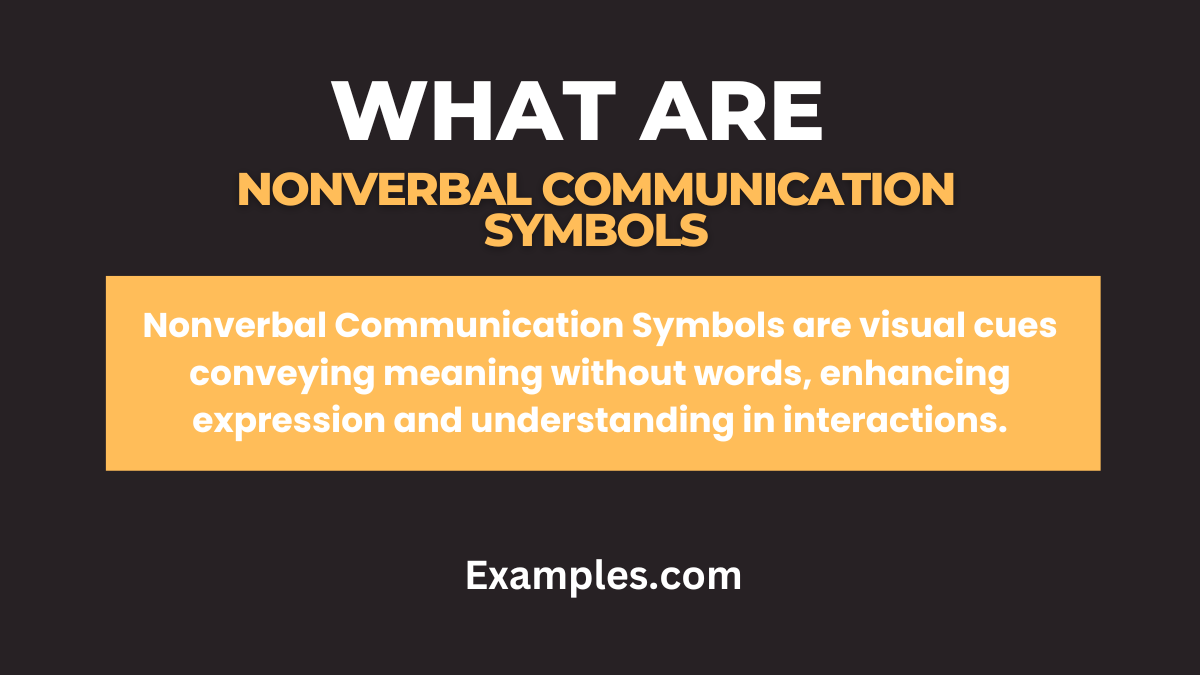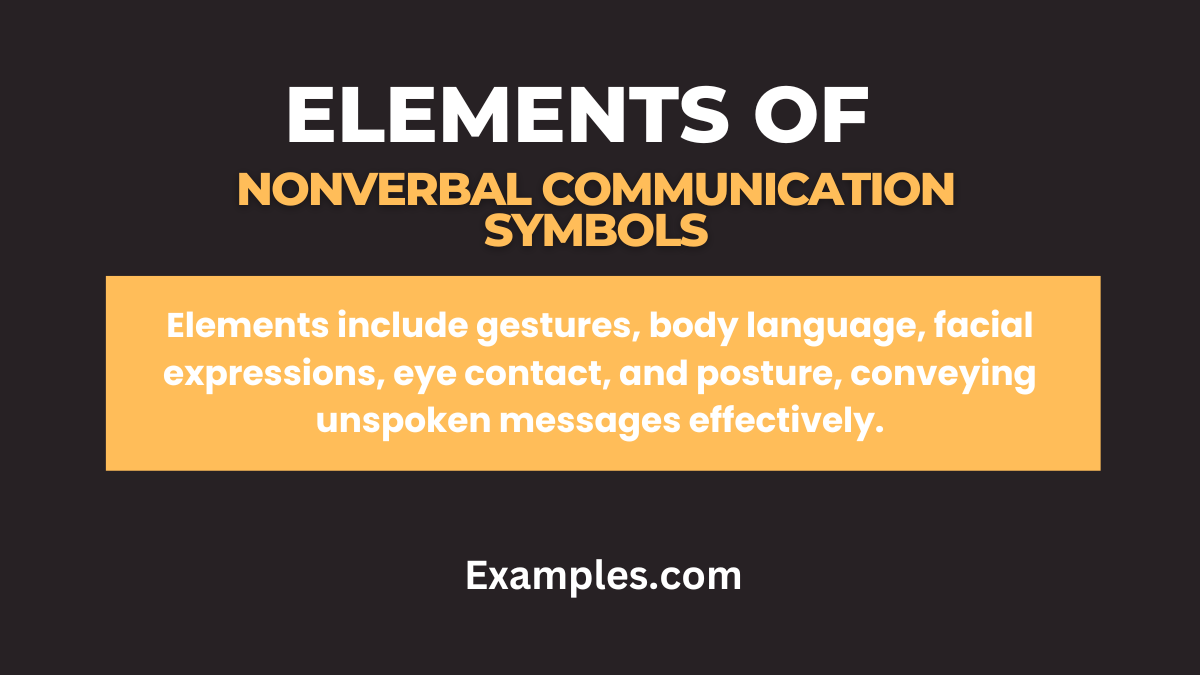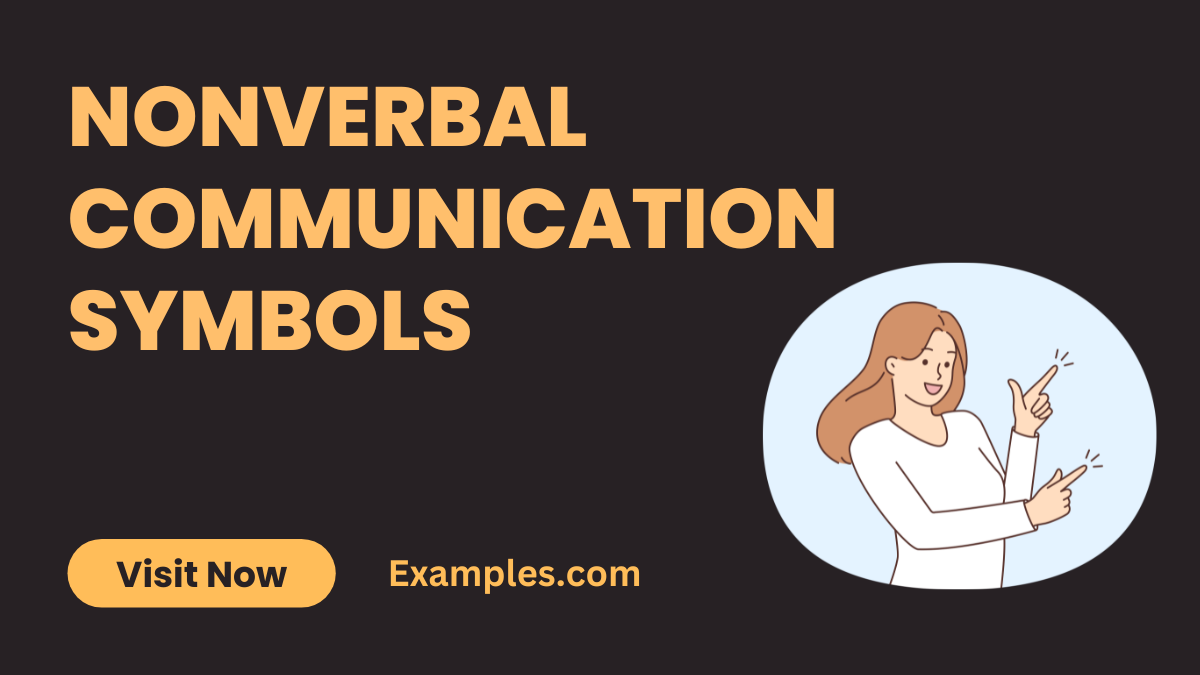29+ Nonverbal Communication Symbols Examples
Unlock the fascinating realm of Nonverbal Communication Symbols in this comprehensive guide. Dive into the intricate web of communication examples, decoding the unspoken language that shapes our interactions.
What are Nonverbal Communication Symbols?

In straightforward language, Nonverbal Communication Symbols encompass the silent cues shaping human interaction. From body language to facial expressions, these symbols communicate thoughts and feelings beyond spoken words. Understanding these nuances is key to mastering effective communication.
30 Nonverbal Communication Symbols Examples

Unlock the intricacies of human interaction with these 30 Nonverbal Communication Symbols. From subtle gestures to expressive cues, each example holds the key to effective communication.
- Facial Expressions: Navigate emotions effortlessly through smiles, frowns, and raised eyebrows. Example: A warm smile fosters a friendly atmosphere during introductions.
- Body Language: Convey confidence with open postures and warmth with inviting gestures. Example: Leaning in subtly signals active engagement in a conversation.
- Eye Contact: Establish connection and trust by maintaining appropriate eye contact. Example: Direct eye contact during presentations enhances credibility and connection.
- Gestures: Amplify spoken words with gestures that add emphasis and clarity. Example: Pointing to a map while giving directions reinforces verbal instructions.
- Posture: Display confidence and authority through an upright and open posture. Example: Sitting up straight in meetings reflects attentiveness and professionalism.
- Proxemics: Understand personal space to ensure comfort and respect boundaries. Example: Maintaining a comfortable distance during conversations fosters a sense of ease.
- Touch: Communicate warmth and empathy through appropriate touch. Example: A comforting pat on the back can offer support in challenging situations.
- Paralanguage: Pay attention to tone, pitch, and speed for nuanced communication. Example: A calm, steady voice conveys reassurance during stressful discussions.
- Haptics: Explore the language of touch for nuanced expressions of emotion. Example: A firm handshake communicates confidence and trust.
- Artifacts: Decode messages conveyed through personal items and clothing choices. Example: Wearing a uniform symbolizes authority and professionalism in certain settings.
- Chronemics: Understand the role of time in communication dynamics. Example: Punctuality signifies respect for others’ time and commitment.
- Oculesics: Read unspoken messages through eye movements and gaze. Example: Rolling eyes may convey disagreement or skepticism.
- Kinesics: Interpret meaning through bodily movements and facial expressions. Example: Nodding in agreement enhances understanding and affirmation.
- Emblems: Recognize culturally specific gestures with distinct meanings. Example: A peace sign universally symbolizes goodwill and harmony.
- Illustrators: Enhance verbal communication with accompanying illustrative gestures. Example: Using hand gestures while explaining a process adds clarity.
- Regulators: Manage conversations with nonverbal cues that guide flow. Example: Making eye contact to signal the end of a discussion turn.
- Adaptors: Uncover hidden emotions through self-soothing behaviors. Example: Rubbing the back of the neck may indicate stress or discomfort.
- Mirroring: Build rapport by subtly imitating gestures and expressions. Example: Mirroring a smile creates a sense of connection and camaraderie.
- Facial Symmetry: Perceive facial balance for insights into emotional states. Example: A raised eyebrow may indicate surprise or curiosity.
- Microexpressions: Detect fleeting emotions that reveal true feelings. Example: A quick smirk may betray concealed amusement or skepticism.
- Silence: Utilize pauses strategically to emphasize points and allow reflection. Example: A brief silence after a profound statement amplifies its impact.
- Body Synchronization: Harmonize movements for synchronized and cohesive interactions. Example: Walking side by side during a conversation enhances connection.
- Cultural Variations: Navigate diverse communication norms for effective global interactions. Example: Bowing is a respectful gesture in many Asian cultures.
- Personal Space: Respect individual comfort zones to foster positive interactions. Example: Giving ample space in crowded places prevents discomfort.
- Fidgeting: Decode nervous energy or impatience through subtle movements. Example: Tapping fingers may signify restlessness or anticipation.
- Regard: Show esteem through attentive and respectful nonverbal cues. Example: Maintaining eye contact during a presentation conveys respect for the speaker.
- Closed vs. Open Body Language: Differentiate between defensive and welcoming postures. Example: Crossing arms may signal defensiveness, while open arms convey receptivity.
- Pitch Variations: Convey emotion and emphasis through pitch modulation. Example: A rise in pitch can express excitement or urgency.
- Mirroring Tone: Match vocal tones to establish rapport and connection. Example: Adopting a calm tone during a crisis helps reassure and calm others.
- Pupil Dilation: Recognize subconscious reactions and heightened interest. Example: Dilated pupils may indicate excitement or attraction.
Nonverbal Communication Symbols Examples in the Workplace
Description: Uncover the subtle language of Nonverbal Communication Symbols in the workplace. Mastering these cues enhances professional relationships, fosters collaboration, and promotes a positive work environment.
- Handshakes: Initiate meetings with firm handshakes for a confident and welcoming first impression.
- Desk Organization: A tidy desk signifies organizational skills and attention to detail, conveying professionalism.
- Eye Contact in Meetings: Maintain consistent eye contact during meetings to express engagement and active participation.
- Attire Choices: Dressing appropriately for the workplace communicates respect for the company culture and colleagues.
- Posture during Presentations: Stand tall with open body language during presentations to exude confidence and credibility.
- Use of Office Space: Personalize office spaces with items that reflect professional interests and values, fostering a sense of identity.
- Response Time: Timely responses to emails and messages demonstrate reliability and effective communication.
- Facial Expressions in Negotiations: Express empathy and understanding through facial expressions during negotiations.
- Proximity in Collaborative Projects: Working closely with team members signals cooperation and a shared commitment to success.
- Time Management Signals: Punctuality and efficient time use communicate reliability and respect for colleagues’ time.
Nonverbal Communication Symbols Examples in Childcare
Navigate the world of childcare with a keen understanding of Nonverbal Communication Symbols. These cues, from comforting touches to facial expressions, play a crucial role in creating a secure and nurturing environment.
- Comforting Touch: Gently patting a child’s back provides reassurance and comfort during moments of distress.
- Facial Expressions during Play: Use animated facial expressions to convey enthusiasm and joy during playtime activities.
- Eye Contact in Teaching: Maintaining eye contact while teaching establishes a connection and aids in effective communication.
- Tone of Voice: A soothing tone of voice helps in calming anxious children and creating a sense of safety.
- Body Language in Discipline: Non-threatening gestures and postures aid in disciplining without causing fear or anxiety.
- Consistent Routines: Establishing predictable routines helps children feel secure and understand expectations.
- Smiles during Learning: Frequent smiles during educational activities make learning enjoyable and encourage participation.
- Proximity in Supervision: Being physically close when supervising communicates attentiveness and ensures child safety.
- Mirroring Emotions: Reflect a child’s emotions through mirroring expressions to validate and empathize with their feelings.
- Use of Play Materials: Thoughtfully choosing play materials conveys a commitment to a child’s development and learning experience.
Nonverbal Communication Symbols Examples for Students
For students, understanding Nonverbal Communication Symbols is essential for effective learning, positive interactions, and successful academic experiences.
- Body Language in Group Projects: Open body language fosters collaboration, creating a positive environment for group projects.
- Eye Contact during Presentations: Maintaining eye contact during presentations boosts confidence and engages the audience.
- Note-Taking Posture: A focused and attentive posture during note-taking enhances information retention and understanding.
- Active Listening Gestures: Nodding and other active listening gestures show engagement during class discussions.
- Facial Expressions in Peer Interaction: Friendly facial expressions contribute to a welcoming atmosphere during peer interactions.
- Use of Personal Space: Respecting personal space in shared study areas promotes a conducive learning environment.
- Feedback Through Expressions: Expressing agreement or disagreement through facial expressions encourages constructive discussions.
- Time Management Signals: Organized time management, visible through schedules and planners, promotes academic success.
- Participation Signals: Raising hands or using nonverbal cues indicates readiness to participate in class activities.
- Posture in Exams: Maintaining an upright posture during exams aids concentration and confidence in one’s abilities.
Why are Symbols Important in Nonverbal Communication?
Symbols hold profound significance in nonverbal communication, serving as a universal language that transcends linguistic barriers. They convey nuanced messages, emotions, and intentions, adding depth and richness to interactions. By tapping into shared cultural meanings, symbols create a common ground for understanding, fostering connection and reducing the risk of miscommunication. Explore how symbols become potent tools, amplifying the impact of nonverbal cues in various contexts, from personal relationships to global interactions.
What are Elements of Nonverbal Communication Symbols?

Delve into the intricate elements that constitute the realm of nonverbal communication symbols. From facial expressions and body language to paralanguage and spatial dynamics, each element plays a crucial role in conveying unspoken messages. Explore how the interplay of these elements influences the overall meaning of communication. Uncover the universality and cultural variations within these elements, gaining insights into the diverse ways individuals express themselves nonverbally. Understanding these foundational elements is key to decoding the intricate language of symbols.
Tips for Effective Nonverbal Communication Symbols
Effective use of Nonverbal Communication Symbols is crucial for successful interactions. Here are five key tips to master this silent language:
- Conscious Body Language: Be aware of your gestures, facial expressions, and posture to convey intended messages accurately.
- Adapt to Context: Adjust nonverbal cues based on the setting to ensure appropriateness and cultural sensitivity.
- Eye Contact Mastery: Develop a balance in maintaining eye contact—too little may indicate disinterest, while too much can be intimidating.
- Listen Actively: Nonverbal cues are equally important in listening. Use gestures and expressions to show engagement and understanding.
- Consistency with Verbal Communication: Ensure that your verbal and nonverbal messages align to avoid confusion and convey sincerity in communication.
In conclusion, nonverbal communication symbols play a pivotal role in conveying our thoughts and emotions where words fall short. These symbols are especially significant in cross-cultural contexts, where linguistic barriers might impede communication. They not only bridge the gap in language but also foster authenticity and understanding among individuals from diverse backgrounds??. Effective nonverbal communication, encompassing body language, facial expressions, and gestures, is crucial in personal and professional relationships. It goes beyond mere words, broadcasting our true feelings and intentions, thus influencing how others perceive and interact with us??.
Moreover, understanding and utilizing effective nonverbal communication techniques are essential. This includes being fully present in conversations, managing stress, and developing emotional awareness. These skills enable us to interpret and convey nonverbal cues accurately, thereby enhancing our interactions and building stronger relationships??. For further reading on the importance and challenges of nonverbal communication across different cultures, consider visiting Psychology Today’s article on Non-Verbal Communication??. Additionally, for a comprehensive understanding of how to improve nonverbal communication, HelpGuide.org offers valuable insights and techniques in their article on Nonverbal Communication and Body Language??.



